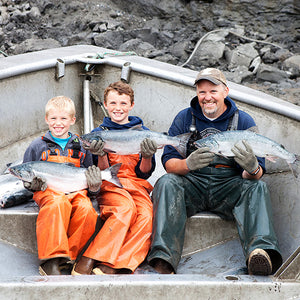This article is part of our first-ever EPIC Impact Journal. For more on this groundbreaking publication and how to get your hands on one, click here.
Since he can remember, Steve Sturman’s days have started and ended on the water. Born and raised 60 miles south of Anchorage, Alaska on the Kenai Peninsula, he’s always felt an intrinsic connection with the frigid seas that line his homeland and the teeming marine life within them. This link — which he saw in his father, a commercial fisherman and his biggest idol, too — was his trail map to deliverance. No longer a boy, Steve steers the skiff and has taken up the family fishing mantle in ways he’d never imagined.
 Photography by Antonia Reitter
Photography by Antonia Reitter
Steve’s father, Fred, moved out to Alaska in 1964 in search of work. A native of Guymon, Oklahoma with deep roots in the oil and gas business, he’d recently been laid off and needed to support his wife and two children, Carl and Cathy. He settled in quickly and, six months later, sent for his family. Fred wasn’t exactly a man bred for marine life, but by 1971, after cutting his teeth as a deckhand and longline halibut fisherman, he made the leap to commercial fishing. A year later, Steve was born.
When he was a child, Steve followed his father everywhere — especially when it was time to go fishing. The perfect blend of sturdy and stubborn, he was always eager to learn and determined to prove he was a capable helper. His father, an old-school, blue collar man who’d braved Alaska in its infancy and practically taught himself to fish, would let him tag along but didn’t grant him any exceptions. The kid had to pull his weight like everybody else. “He wasn’t going to coddle me or put me under his wing,” Steve laughed. “He would take me begrudgingly because he knew that my mom would skin him if anything happened to me.”
 Photography by Antonia Reitter
Photography by Antonia Reitter
Fred was all about tough love because he wanted more for his son. He pushed Steve to become a better fisherman but also to pursue an education since salmon fishing season only spans from about Memorial Day to Labor Day — making it a tough industry to rely on year in and year out. So Steve shipped off to Nampa, Idaho to get his degree in Elementary Education from Northwest Nazarene University. It seemed like the perfect plan. “It was so simple: you teach up until the first couple weeks of May and then you’re off for the summer to fish,” Steve said.
But a semester of student teaching 5th graders was all it took for Steve to know he wasn’t cut out for teaching. There was just too much structure. He felt like a caged animal. So he picked up a few seasonal jobs over the years, working as a bag handler for Alaska Airlines and UPS driver when he wasn’t fishing during salmon season. He loved it. But when his wife, Tesa, gave birth to their son, Colby, he knew things had to change.
So in 2005, Steve went all-in and founded his own fishing company. He named the company Fred’s Alaska Seafood in tribute to his father, who had suffered a heart attack a few years before and could no longer suffer the rigors of a 12-hour day of fishing. He was eager to implement quality fish treatment practices in an effort to market his salmon to American markets — an atypical approach considering the majority of fish the region went abroad. “I’d see all these fish go overseas. We’d always joke they were getting a one-way ticket to Tokyo,” Steve explained. “I knew there was a domestic market in the United States for wild-caught salmon and I was gonna do my darndest to pursue it.”
 Photography by Antonia Reitter
Photography by Antonia Reitter
And that’s exactly what he did. Bent on reaching U.S. buyers, Steve flew his family to Dallas, Texas for a winter to try his hand with consumers in America’s heartland. People laughed at him — “everyone thought people only ate cattle and catfish down there” — but he didn’t care: he was going to prove Americans far from his icy waters wanted to eat fresh, top-notch salmon. He was right: people went wild. They’d never had anything like it. Fred’s slowly grew in popularity, working its way into the Dallas farmers market and getting a few newspaper features. But Steve’s biggest breakthrough came through brick-and-mortar organic co-ops, where masses of consumers loved knowing the personal connection he had with this fish. “More and more, people want to know the origin of their food,” he said. “People want to know the story and they want to know who’s behind it. Nobody can sell your passion like you can.”
Dallas was a key turning point. Since then, Fred’s has exploded into American markets, especially in the southeast. This has allowed Steve to expand their operations and invest money in things like better shipping abilities and a massive walk-in freezer — to Tesa’s relief, since the fish had previously been kept in huge chests in their garage, exposing their cars to Alaska’s sub-zero winters. But Steve isn’t looking to take Fred’s global or losing sight of the little things. He prides himself on the quality of care they provide their fish, including icing them immediately upon capture and keeping them cold all the way up to the processor. “It’s the little things that preserve and enhance the taste of the fish and let the consumer know there’s true care taken,” he explained.
Staying small was always part of Steve’s plan. By keeping a lean crew comprised of 7-8 members — including his sister, Cathy — and a couple skiffs, he’s able to enhance their practices while maintaining a hands-on role in the water every day. Considering they can bring in up to 40,000 pounds of salmon on a good day and typically work from 7:00 AM — 7:00 PM in-season, that’s nothing to sneeze at. But Steve’s not complaining: he’s doing what he loves. “I always thought it would just be cool to start a company, fish, and support my family while reflecting well on Alaska and my industry,” he reflected. “I’m living the dream.”
 Photography by Antonia Reitter
Photography by Antonia Reitter
It’s always been about fishing and family for Steve. He’s not certain which of his three sons — Colby (11), Brett (9), and Gage (7) — are most likely to carry on the Sturman fishing legacy, but he’s not losing sleep over it. He just wants them to pursue their passions as feverishly as he did. As for his dad, the namesake ofFred’s Alaska? “He’s more inclined to just stay on the beach and tell me what I’m doing wrong,” Steve joked. “He’s there to listen, offer guidance, and share stories with me, but mom would kill me if I took him out and anything happened to him.”
A few decades and many fish later, the boot’s on the other foot.



